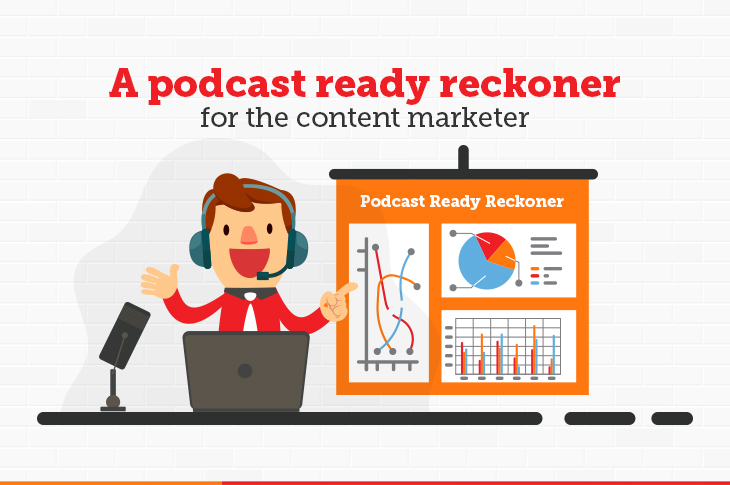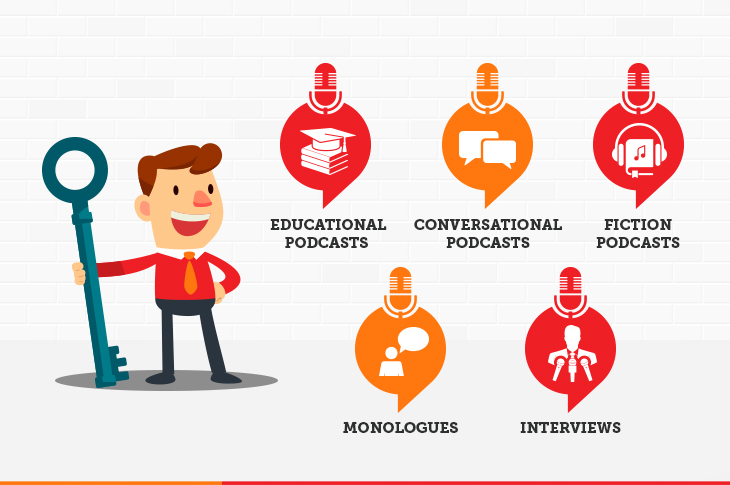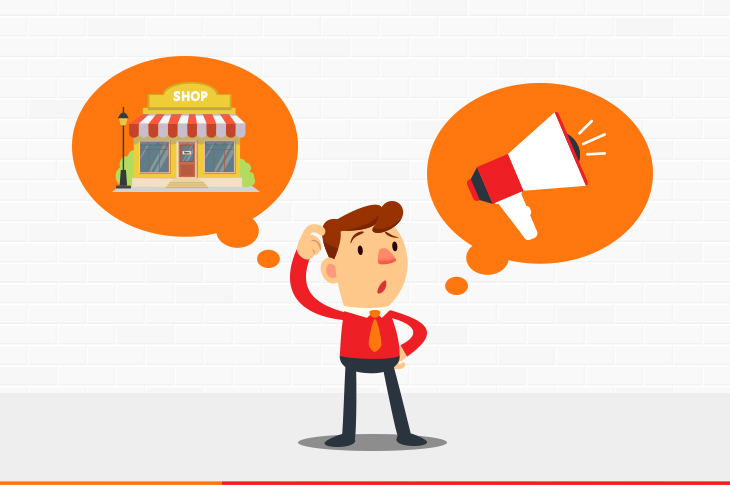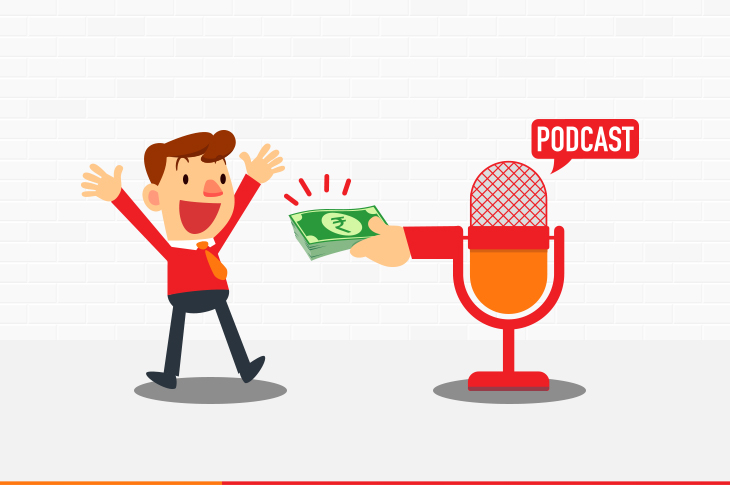A podcast ready reckoner for the content marketer

The word ‘podcast’ is common today, but what is it, and does it really help you as a content marketer? Let us take a closer look at this form of content dissemination.
What is a podcast?
The Oxford English Dictionary defines the word as ‘a digital audio file of speech, music, broadcast material, etc., made available on the internet for downloading to a computer or portable media player; a series of such files, new installments of which can be received by subscribers automatically.’ In simple terms, a podcast is an audio file that is downloaded automatically to the user’s device.
The term has evolved since its inception to include audio files that are available on streaming services as well, as long as they fit the concept of content of a podcast. Podcasts can follow the format of a radio show, but it isn’t necessary for them to follow any format at all. Podcasting can be an extremely useful tool for content marketing, when used properly.
Why are podcasts so popular?
Podcasting is a disruptive medium – it usually costs nothing. If it does have a fee, it is usually a nominal charge that offers extras that aren’t made available to unpaid subscribers. Podcasts are convenient because they download themselves to the device you use as soon as a new episode is available.
This used to involve plugging in your music player to your computer to auto-download the audio file in the early days of podcasting, but today it can be as simple as a notification from your streaming service of choice on your smartphone. Unlike a radio show, the listener has control over when to listen to it – the Play and Pause buttons are at their disposal. So, a podcast can be listened to at the gym, while driving, or simply while sitting and doing nothing.
Why do people listen to podcasts?
Added to the convenience that we described above is the plethora of podcasts available. A consumer can choose from different genres of podcasts, just like choosing videos on YouTube. This provides content marketers with a unique advantage: the audience is a targeted one.
What are the key features? What are the different types?

If you’ve ever listened to a radio show, you would have got a fair idea of what a podcast is like. However, as mentioned before, unlike a radio show that is optimized to showcase the sponsors, a podcast can have any format whatsoever, it being born free from the shackles of the target of making money for the most part. As such, there can be infinite kinds of podcasts, which is great news for content marketers, since it can be customized to suit individual tastes.
Podcasts broadly fall into a few different types:
Monologues are the simplest form of a podcast. They involve a single person talking about a topic (or five), or telling a story. Their simplicity means that a minimum of audio editing and setup is required. As a result, this is the most popular podcasting format.
Interviews are just what they sound like: a host is consistent across all the episodes of the podcast, and guest speakers are invited to share their thoughts on their area of expertise. This kind of podcast has the ability to run for many episodes since the topics can range widely. As long as an expert from the field can make it for the interview, there will be content for an episode.
Conversational podcasts have more than one host, and the podcast is nothing but a conversation that occurs between the hosts. The tone is quite informal compared to an interview-type podcast, and part of the fun is listening to the banter between two or more people with good chemistry.
Educational podcasts can follow the format of either interviews or conversational podcasts, but they focus on educating the listener on a topic. That can be cooking something or travelling to a particular place or learning a new language. It can be a little difficult to approach a subject that needs a lot of visual aids, like graphic design or painting, but an educational podcast about these subjects, when done well, can encourage the listener to progress to videos and websites that will help get the message across. This is quite a challenge for content marketers, but get them to follow and you know you’ve got it right! Educational podcasts can also choose to report and opine about current events, much like expert interviews.
Fiction podcasts can range from a short story or audiobook to an audio enactment of a play. These are purely for entertainment and depending on the level of detail, they can require a massive amount of investment to set up.
How do you structure them?
As we’ve been saying all along, there is no real need to follow any structure for a podcast – but as a content marketer, you will be aware of the benefits of good storytelling. A good podcast has three main sections: an introduction, the main body, and an outro.
The introduction is where you’ll introduce yourself, your podcast, and any guests. You’ll also give your listeners a teaser about what to expect.
The main body will have the meat of the matter – remember to stick to a storytelling format that tells your listeners what set you down the path of choosing the topic of the episode, the conflict and the journey of discovery, and finally, the resolution. This part of the podcast can have more than one topic but remember not to bounce back and forth between topics. If having a rough script will help you do this, write one down. Remember to link the different topics as well; don’t abruptly jump from one to the other. If you have a Q&A session with your listeners, here is where you’ll have it, at the tail end of the main body.
The outro will summarize the episode, thank the guests (if any), and sign off with a reminder of when the next episode will be.
A call to action can be given anywhere in the podcast – traditionally it was at the end, but of late it is contained in the segue from the introduction to the main body. You can also insert a CTA in the main body – but do this only if it comes organically. You don’t want it to come across as an obvious plant.
Are they good for business? Are they good for marketing?

Studies have shown that podcast listeners are a loyal bunch, and they tend to be of above-average financial means. That means getting a loyal audience might be a challenge, but there’s no reason they won’t stick if your content is solid. Your podcast can help promote you as an expert in your field, thus increasing the trust of your audience in you.
Sure, words on a screen can do that as well, but they lack the emotion that a voice can convey to a listener. Video can convey emotions much better than audio, but just like reading, videos demand your audience’s full attention, thereby reducing the chances that your audience will stay till the end of your video or written article. As a content marketer, you will know that the value of an audience that is loyal, perceives you as trustworthy and feels close to you, and stays until the end of your message, is worth its weight in gold.
Podcasting also offers quite a few of the benefits of video – for example, emotions are conveyed better and the time used to consume the content is less – but without a lot of the negatives of video like investment in equipment and locations. The inherent advantages of podcasting (such as a quick turnaround time) can also allow you to make it interactive, by accepting queries from consumers and incorporating the voices of your consumers in upcoming podcasts. This level of connect is something that is rarely achieved in content marketing, and podcasting makes it quite accessible.
How do I start a small business podcast?
There are two parts to the answer of the first question. The first bit is the issue of logistics: you need to have the right equipment to record a podcast. Theoretically you can record a podcast with just your mobile phone, but it will not offer the kind of quality you’re used to listening to on a regular podcast. For a solo podcaster, a USB mic plugged into your computer can be a good starting point. Free digital audio workstations (DAWs) like GarageBand will help you record and edit audio – the learning curve can be a little steep, but it is not overly complicated.
For Windows users, Audacity or Cakewalk by BandLab are a couple of feature-rich DAWs that offer a lot of options. You can bump up your audio quality significantly by using an ‘audio interface’. This is a device that will amplify the signal from your microphone and also convert your voice into digital signals that can be recognized by the computer and fed into the DAW.
A mid-spec dynamic mic will serve your needs well enough, budget Rs 5000–8000 for it. As a beginner, you won’t really need a condenser mic for your podcast – in fact, without a really quiet recording environment, a condenser mic might prove to be a handful because of its propensity to pick up a lot of background noise. You’ll need more mics and more inputs on your audio interface if your podcast is going to have more than one person speaking so that you can record and edit each person as a separate audio track, and there’s a whole different level of complexity involved for remote interviews.
Do I need a website for my podcast?
The simple answer to this question is no, you don’t need a website for your podcast – but there are a great many advantages if you do make one. Domain names and hosting aren’t all that expensive these days, and with the right SEO, your content marketing strategy can make sure that a Google search for your podcast shows up at the top of the results. This is a good thing for a number of reasons: you don’t have control over how a podcasting service optimizes search results for your podcast, and you’re not sure if the person conducting the Google search has that podcast streaming service app installed on their device. Having the ability to play it directly via a web browser can be very convenient for your audience.
You also have control of SEO for individual episodes, which is always a plus. You can help draw people to your website by offering bonus content to those who sign up on your website – and that in turn gives you user data. Your website analytics will give you a lot of information about your audience: where they’re coming from, how long they’re spending on your website, etc – which you may or may not get from a podcast hosting service. Getting subscribers and listeners to engage in a discussion on your own website is also easier than the alternatives. You can also put a ‘donate’ button on your website; after all, your podcast has the ability to earn you an income directly as well!
How do podcasts make money?

We already mentioned one avenue – a ‘donate’ button on your website – for generating revenue. You can also offer a paid subscription model, with paid subscribers getting extra content or access to content archives. Podcasts are one of the highest-growing mediums for content marketers, so the traditional route of sponsorship is also available to you. If you’re reviewing goods that are available for purchase online, you can go down the affiliate marketing route to generate revenue. You can also sell physical goods or services via your podcast, making it your marketing vehicle.
What are the disadvantages?
SEO is quite difficult for a podcast. Content marketing is relatively easier with the written word, where you can insert your relevant keywords to increase your page ranking in a Google search result. However, a podcast is an audio file, so there is no easy way for Google to currently know what your podcast is about, or what keywords it should relate it to. The podcast audience is growing extremely rapidly, but that doesn’t change the fact that it is still a limited audience right now. You will also have to be very careful with intellectual property – if someone copies your podcast containing something copyrighted that you have used with permission, it can have legal implications for you.
What are some good business podcasts to listen to in India?
The Indian Startup Show hosted by Neil Patel is a very popular podcast, thanks to its content. It is a very long-running show, so you’ll have a lot of content to go through should you feel like binge-watching it.
The Moneycontrol podcast is a daily podcast that offers advice on various business-related topics such as investment analysis and advice on the stock market.
Seamless working between remote teams has never been more important than it is today.
Scatter Content Box – a purpose-built platform – enables better digital asset management, streamline sharing, easy collaboration and improved productivity for marketers.
Ask for a demo to learn more about how it can help your business.
